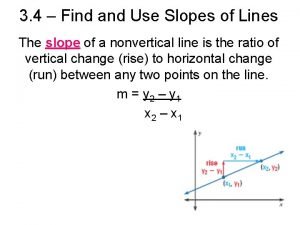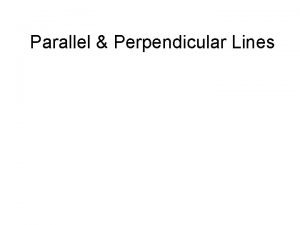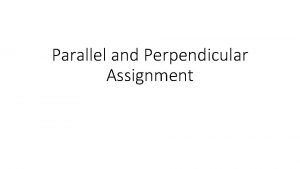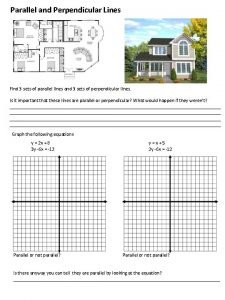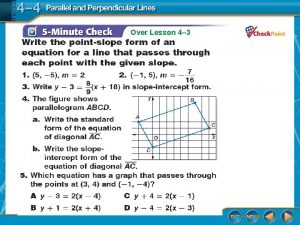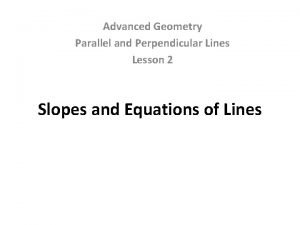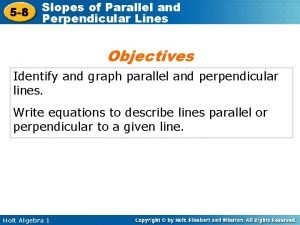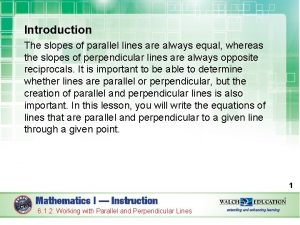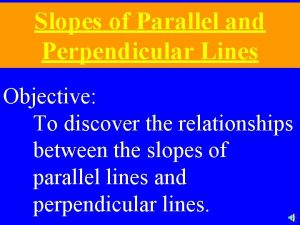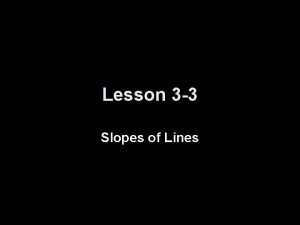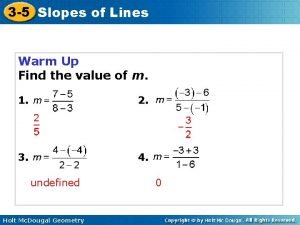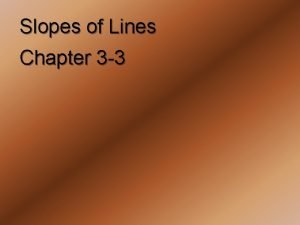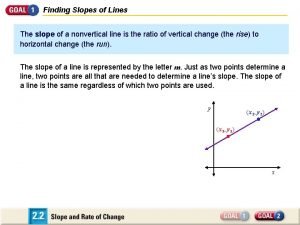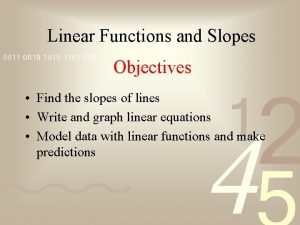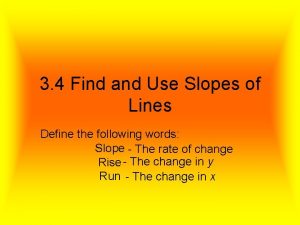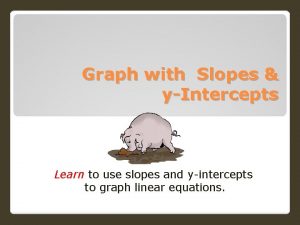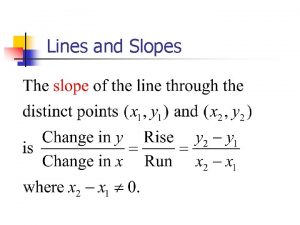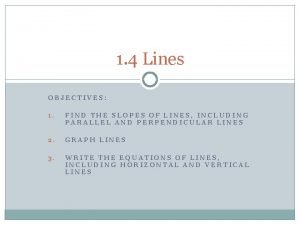3 4 Find and Use Slopes of Lines













- Slides: 13

3. 4 Find and Use Slopes of Lines

Basics of Slope • Slope (of a Line) – The vertical change (rise) of the line divided by the horizontal change (run) of the line. • Slope is represented by the letter m in an equation. Rise Run

Types of slopes • Negative Slope – Driving Downhill – m is negative • Positive Slope – Driving Uphill – m is positive • Zero Slope – Driving on a flat road – m is 0 • Undefined Slope – A cliff or a wall – m is undefined Identify each type of slope in the graph above

Find the Slope when given two points Remember slope is represented by m m=rise/run 1. Label the x and y for each point 2. Rise – The difference in vertical change Subtract the y-values as shown 3. Run. The difference in horizontal change Subtract the x-values as shown 4. Divide the rise by the run Rise Run

Find the slope of the line • Remember slope is represented by m • Label your x and y for each point • Keep the slopes written as fractions 1. (0, 4) and (4, 0) 2. (0, 4) and (5, 8) 3. (-3, -2) and (4, 0) 4. (-2, 3) and (3, 3) 5. (2, -1) and (-1, 2) Rise Run

Comparing Slopes • The steeper line has the slope with the greater absolute value.

Parallel Slopes • Two lines are parallel if they have the same slope

Example: Find the slope of each line. Which lines are parallel? •

Your Turn Find the slope of each line. Are the two lines parallel? 1. Line 1: (-3, 1), (-7, -2) Line 2: (2, -1), (8, 4) 2. Line 1: (-2, -1), (1, -2) Line 2: (-5, -3), (-1, -4) 3. Line 1: (-3, -2), (1, 2) Line 2: (1, 3), (4, 6)

Perpendicular Slopes • Two lines are perpendicular if the product of their slopes is equal to -1. • The two slopes will be negative reciprocals – Negative reciprocal: Flip the fraction and change the sign

Example: Line h passes through (3, 0) and (7, 6). Graph the line perpendicular to h that passes through the point (2, 5). •

Your Turn Find the slope of each line. Are the two lines perpendicular? 1. Line 1: (1, 1), (3, 3) Line 2: (2, 2), (0, 4) 2. Line 1: (-5, 2), (-3, 5) Line 2: (-2, 2), (1, 0) 3. Line 1: (-2, 3), (-5, 2) Line 2: (4, 1), (5, 3)

Graph a line given the slope and a point •
 Find and use slopes of lines
Find and use slopes of lines Parallel lines same slope
Parallel lines same slope Parallel and perpendicular lines worksheet doc
Parallel and perpendicular lines worksheet doc Slopes of parallel and perpendicular lines assignment
Slopes of parallel and perpendicular lines assignment 3 sets of parallel lines
3 sets of parallel lines Slopes of parallel and perpendicular lines lesson 8-1
Slopes of parallel and perpendicular lines lesson 8-1 Lesson 2-4 parallel and perpendicular lines
Lesson 2-4 parallel and perpendicular lines 5/8 perpendicular
5/8 perpendicular Slopes of parallel lines are always
Slopes of parallel lines are always Two lines are parallel if their slopes are
Two lines are parallel if their slopes are Lesson 3-3 slopes of lines
Lesson 3-3 slopes of lines 3-5 slopes of lines
3-5 slopes of lines 3-3 homework slopes of lines
3-3 homework slopes of lines Slopes of lines
Slopes of lines
